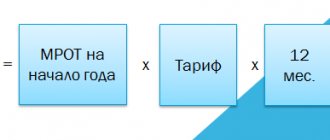Wages are remuneration paid for the performance of labor duties. The amount of payment is the main condition of employment, influencing the choice of place of work. There are real and nominal types of remuneration. In this article we will tell you what real and nominal wages are, how they differ, and how they are calculated.
Nominal wages are understood as the remuneration due to an employee for the performance of work duties. Real payment is a valuation of the volume of goods or services that can be purchased for the amount provided. Real income shows the purchasing power of nominal wages.
Characteristics of real wages
The level of real wages depends on nominal payments, consumer prices for goods or services, and the influence of additional indicators. The real cost of wages is a reflection of the market economy. Factors reducing real wages:
| Index | Characteristic |
| Size and content of the consumer basket | Increase in prices for goods or services |
| High unemployment rate | Employees are hired at a lower labor price |
| Structure of labor market price offers | Declining demand for highly skilled labor |
| Taxation | Introducing new types of taxes or increasing rates |
| Delay in remuneration payments | Amounts received later than the due date have a lower purchasing value due to the influence of inflationary processes |
| State indexation of budget payments, the size of the minimum wage | Lagging value of indexation from inflation growth |
The intervention of government regulation makes it possible to partially balance the distortions of market processes. Measures of influence include economic, social levers of a legislative and regulatory nature. State regulation of market relations is characterized by short periods of development and application of measures and the absence of preliminary planning.
How is nominal wage calculated?
There are two closely interacting categories in the labor market: employers and employees.
The latter are ready to exchange their services for a monetary reward. Its size is calculated based on labor costs per unit of time. Personal factors, such as employee expenses for personal needs, as well as current market prices for goods and services, are not taken into account here.
Since wages are regarded as income received by an individual, citizens pay part of it to the state treasury in the form of taxes and insurance contributions. Naturally, the resulting salary amount will be less than that agreed upon by the terms of cooperation with the employer.
Without delving into complex economic concepts, we can say that a nominal salary is a sum of money that is accrued to an employee on paper and appears only in accounting documents. Its size is calculated taking into account the amount of work done over a certain time period (hour or month), but without taking into account various taxes and fees.
It includes the main part of the remuneration, calculated according to the adopted tariff schedule, as well as mandatory additional payments, coefficients and bonuses.
In addition, the nominal salary includes additional remunerations, which include:
- payment for sickness absence,
- vacation pay,
- payment for forced downtime,
- maternity and baby care time,
- preferential hours when employing minors,
- compensation upon dismissal.
Thus, the additional part of the salary includes all types of payments for the time during which the employee did not actually perform his official duties.
Relationship between types of remuneration
A simple approach to estimating nominal remuneration suggests that higher wages lead to more consumption. At the same time, economic processes do not provide a direct relationship between the amount of consumption and the funds received.
The growth of nominal wages fuels inflationary processes. In the economic community there is a rise in prices, affecting the volume of consumption. No matter how quickly wages increase, inflationary processes react more flexibly to the appearance of an additional mass of money on the market.
As a result, there is an inverse relationship between real wages and consumer price growth. The more dynamic the inflationary processes, the lower the real amount of remuneration. When indexing wages, there is a direct dependence of the growth of real wages on nominal wages, but the dynamics of change do not coincide.
Inflation processes for the year
The rate of inflation is determined over annual and monthly periods. There are publications of annual size and broken down by month. The calculation of statistics is based on the consumer price index. The index is calculated as the ratio of the values of the current consumer basket to the base year. Before the start of the annual period, Rosstat makes a forecast that does not always coincide with the result.
| Year | Inflation rate |
| 2016 | 5.4% (forecast 8-8.5%) |
| 2015 | 12.9% (forecast 8%) |
| 2014 | 11.36% (forecast 5.5-6%) |
| 2013 | 6.45% (forecast 5-6%) |
To determine the decrease in real income for the year while nominal wages remain unchanged, the formula is used:
D real = D nominal / (1 + I), where:
- D real – real income;
- D nominal – nominal income;
- I is the amount of annual inflation growth. The impact of inflation on monthly income is calculated in a similar manner.
An example of the impact of inflation on real wages
Employee M. received wages for January 2015 and January 2016 in the amount of 28,000 rubles. Let's calculate the change in real wages due to inflation processes. To simplify the calculation, taxation is not taken into account.
- Let's determine the amount of decrease in real wages for 2015: Z2015 = 28,000 / 1 + 0.129 = 24,800.71 rubles.
- Let us determine the decrease in real wages for 2015: R2015 = 28,000 – 24,800, 71 = 3,199.29 rubles.
- Conclusion: The real cost of wages for employee M., with an equal nominal value, decreased in 2015 by 3,199.29 rubles.
Real and nominal wages
The real wage is the amount of goods and services that can be purchased for a nominal wage.
Nominal salary is the remuneration accrued to an employee for his work, depending on the number of hours worked or the volume of work performed. These 2 wage-related economic terms are interrelated and are usually used together. Everyone, without exception, is familiar with nominal wages - employees see it on their payslips, although they do not use the term “nominal”. We are also very familiar with real wages - this is what is in our wallets and on bank cards.
Is the employer obliged to index wages, ConsultantPlus experts explained. Get free demo access to K+ and go to the HR Guide to find out all the details of this procedure.
You can learn more about the primary documents related to payroll from the materials posted on our website, for example: “Sample of filling out the payroll sheet T-49” or “Unified form No. T-54 - personal account” .
The value of real wages (WW) depends on many factors. For example, if a company is late in paying salaries, this fact reduces the real purchasing power of employees. In our country, not only the workers themselves are trying to fight this phenomenon through trade unions, whose duty is to protect the interests of workers. The state also regulates this issue.
IMPORTANT! If the employer paid wages with a delay, he is obliged to pay compensation in accordance with Art. 236 Tax Code of the Russian Federation. The very fact of delay may serve as a reason for administrative punishment (Part 1 of Article 5.27, Part 4 of Article 5.27 of the Administrative Code), and criminal liability cannot be excluded (Article 145.1 of the Criminal Code of the Russian Federation).
Read more about compensation for late payment for work here.
We will talk about other factors that can influence the level of RRP in the next section.
Nominal wage index
The growth dynamics of both types of wages differ depending on inflation processes in the country. The dynamics are calculated using indices obtained by calculation. When analyzing the dynamics of nominal wages, indicators of changes in income growth are used.
The nominal wage index is calculated using the formula for the ratio of current wages to payments of the previous year: I nom = Ztg / Zpg x 100 (%), where:
- And nom is the index of nominal wages, expressed as a percentage;
- Z tg – wages of the current year;
- Z pg – wages of the previous period.
The simplicity of the formula shows the direct dependence of the index on the growth of nominal payments, regardless of other economic processes.
These statistics provide users with indicators of nominal and real wage growth by industry. Average monthly nominal earnings are established based on actual data from statistical reporting submitted by enterprises. The dynamics of changes in real wages is influenced by the consumer price index. The information is not reliable enough due to the widespread practice of “gray” salaries.
Salary in statistical reporting
Nominal and real wages are also used to obtain statistical indicators.
Formulas for their calculations are used not only at the state, but also at the international level. The results obtained are provided by states that are members of the Eurasian Economic Union to compare the living standards of the population of different countries. You can find more complete information on the topic in ConsultantPlus. Free trial access to the system for 2 days.
Real wage index
The dynamics of changes in real income is determined by the calculated value - the index. The indicator is calculated by dividing the indices of nominal wages and consumer prices.
The formula is applied: And real = And nom / And pc (%), where:
- And the real is the index of real income;
- And nom – index of nominal income;
- And pc – consumer price index.
An example of determining the real income index
In December 2015, employee V. received income in the form of a salary in the amount of 24,000 rubles. In January 2016, the company increased the employee’s salary to 25,000 rubles. Let us determine the growth of real income with the consumer price index in January 2016 relative to December 2015 being 101.0%.
- We determine the nominal wage index: I nom = 25,000 / 24,000 x100 = 104.17%.
- Let's determine the real wage index: And real = 104.17 / 101.0 = 1.03.
- Conclusion: the dynamics of growth of real and nominal income are different.
A comparative analysis of index growth allows us to identify the size of the discrepancy in dynamics and, if necessary, determine the reasons for changes in growth. The difference in the dynamics of indicators is greatly influenced by inflationary processes in the country.
Calculation method
real wages and real monetary incomes of the population
Some media question the correctness of the generally accepted methodology for calculating real wages recommended by the ILO, as well as the reliability of the statistical information provided by Belstat and cite calculations made by some individuals.
The authors of such calculations should be aware that to recalculate cost indicators into comparable prices, a composite consumer price index is used, which characterizes the depreciation or growth (in case of deflation) of the purchasing power of the monetary unit. It should be taken into account that the methodology for calculating the consumer price index is based on the actual structure of consumption of goods and services by the population, and the minimum consumer budget is based on the standard consumption of goods by the population and the method of calculating real wages using the minimum consumer budget is incorrect.
One of the basic principles of organizing statistics is the comparability of statistical data. In this regard, to calculate changes in nominal wages in the reporting period, data on wages for the corresponding period of the previous year are used in the reporting year methodology (data contained in the respondents’ reports), since the list of respondents can be changed due to liquidated and newly created organizations.
The real wage index for January-February 2009 compared to January-February 2008 (accrued average wage per employee, taking into account the CPI) was 4%. Below is the calculation of this indicator.
The nominal accrued average salary for January-February 2009 amounted to Br 912,172, for January-February 2008 - Br 759,905 (taking into account changes in the list of respondents).
The change in nominal accrued average wages was 120% (912,172 Br: 759,905 Br x 100%), the change in real wages was 104% (120: 115.4 x 100%).
Now a few words about the relationship between the average size of assigned pensions and the minimum consumer budget of a family , conventionally consisting of four people, with two children. To correctly calculate the ratio of the average assigned pension to the minimum consumer budget, it is necessary to use the corresponding budget of pensioners, which Belstat does. The ratio of the average size of the assigned pension to the minimum wage of a family of pensioners in February 2008 was 1.270, in February 2009 - 1.236, that is, there was a decrease of 2.7%.
The growth rate of real cash income of the population in January-February 2009 compared to January-February 2008 was 106.5%, despite the fact that the real growth rate of the main source of cash income - wages and pensions, scholarships, benefits and other transfers to the population - below. It should be taken into account that in the structure of cash income, in addition to wages and pensions, scholarships, benefits and other transfers to the population, a fifth part is occupied by income from property and other income. They include income from the sale of agricultural products, from business and other income-generating activities (from the sale of goods through consignment stores, the sale of scrap ferrous and non-ferrous metals, waste paper, etc.).
Other income (receipts from the sale of agricultural products, income from business and other income-generating activities and other income) in January-February 2009 amounted to 22.7% in the structure of cash income compared to 20.8% in January-February 2008 and increased during this period in real terms by 16%.
Income from property in January-February 2009 amounted to 2.5% in the structure of cash income against 1.9% in January-February 2008 and increased during this period in real terms by 42.3%. The growth rate of property income was mainly affected by the increase in interest on household deposits during this period. In property income in January-February 2009, interest on deposits amounted to 89.6% against 85.2% in January-February 2008 and increased during this period in real terms by 49.7%.
National statistics are based on scientifically sound methodology that meets international standards. This has been repeatedly confirmed by international experts who visit our country every year. This is also evidenced by the fact that Belarus joined the IMF Special Data Dissemination Standard in 2004, since the most important condition for accession was the compliance of the statistical methodology with international requirements. In addition, since 2008, our country has been an official member of the UN Statistical Commission.
Elena KUKHAREVICH, Deputy Chairman of the National Statistical Committee of the Republic of Belarus
When nominal and real incomes are compared
The ratio of types of wages allows you to monitor inflation processes. An imbalance between real consumer demand and income supply shows the unsettled nature of economic processes, in which abrupt fluctuations in each direction are an unfavorable factor in economic development.
By comparing real and nominal wage indices, the following indicators are judged:
- Inflationary processes;
- Unemployment level;
- Needs for qualified personnel;
- The need to take corrective measures.
There are many mechanisms for regulating the actual level of available funds. One of the successful mechanisms is to link the amount of remuneration to the minimum wage. The value of the indicator is set at the state level. Read also the article: → “Minimum wage (minimum wage) in the table by year.”
How does real income differ from nominal wages?
The differences between nominal and real wages are that one reflects the quantitative aspect of remuneration, and the other the quality of life that a given income can provide. The first determines the cost of services of specialists of a particular category in the labor market, the second makes it possible to determine the level of well-being of an employee.
Nominal payment determines the employer's expenses for paying an employee. Its size is determined by factors such as:
- demand for the profession,
- supply and demand relationship,
- employee qualification level,
- employee working conditions.
It should be noted that wages also depend on the region of residence. In large cities and rural areas, prices for specialist services can vary significantly. Workers who have a rare profession or a high level of qualifications can also count on higher pay for their work.
The real salary depends on the tax rate adopted by the state, the value of tariffs for services and prices for goods. Despite the fact that it is growing in monetary terms along with the nominal value, its dynamics are not always positive.
With high inflation, price growth outpaces the indexation of labor income, that is, the purchasing power of money decreases. Accordingly, the standard of living of working citizens is deteriorating. Income growth is observed only with a constant inflation rate and a regular increase in nominal pay.
Comparative dynamics of growth processes
There are several options for how changes in wages depend on inflation.
| Nominal income | Inflation | Real income |
| Height | Equal pace | Stable level |
| Height | The pace is lagging | Increase. Occurs rarely and in certain groups of workers |
| The size does not change | Decline | Height |
| The size does not change | Height | Decline |
In the latter option, there is a gradual decrease in the real incomes of citizens. In the absence or delay of indexation, dangerous consequences may arise in the form of hyperinflation and commodity saturation of the market.



